EERZ (Effective Equilibrium Reaction Zone) Model of Gas-Slag-Metal Reactions in the Application of Unconstrained Al-Ni-Cr-Co-Cu Metal Powders in Submerged Arc Welding: Model and 3D Slag SEM Evidence
Abstract
:1. Introduction
2. Materials and Methods
2.1. Welding Tests
3. Results
3.1. Weld Metal Chemistry
3.2. Mass Balance
3.3. Exothermic Heat from Aluminothermic Reduction Reactions
3.4. Speciation and Distribution of the Alloying Elements in Post-Weld Slag

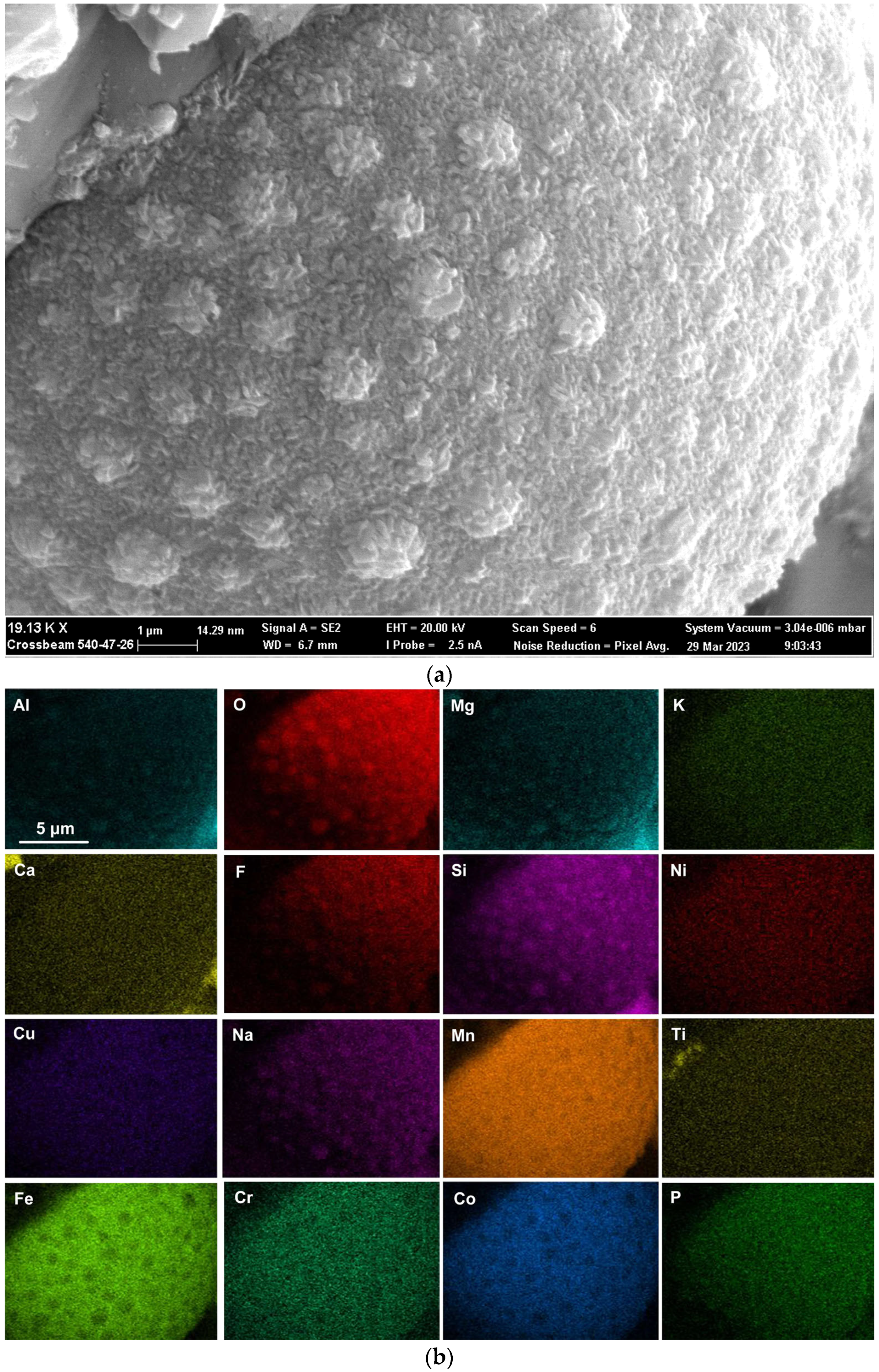
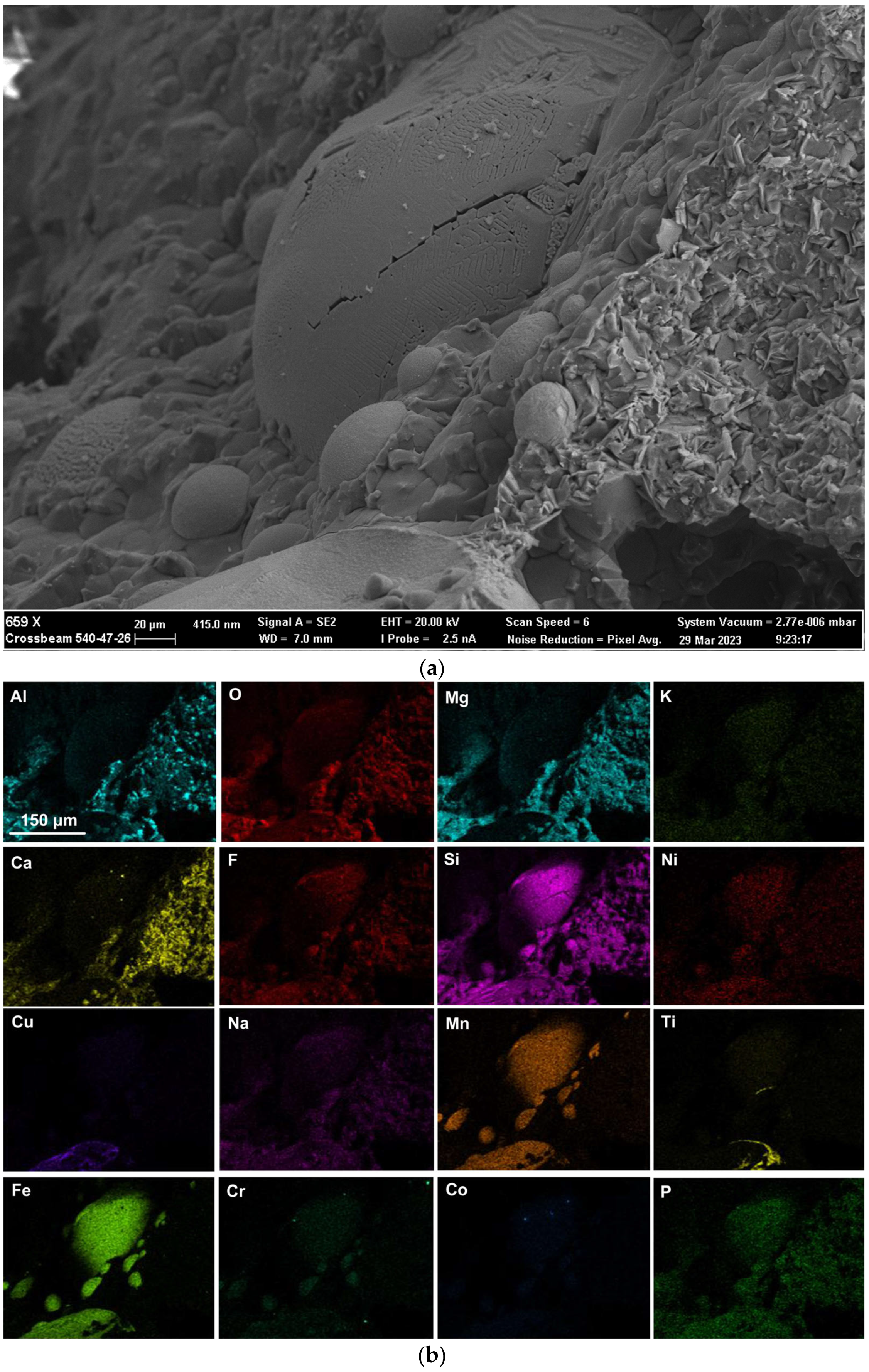
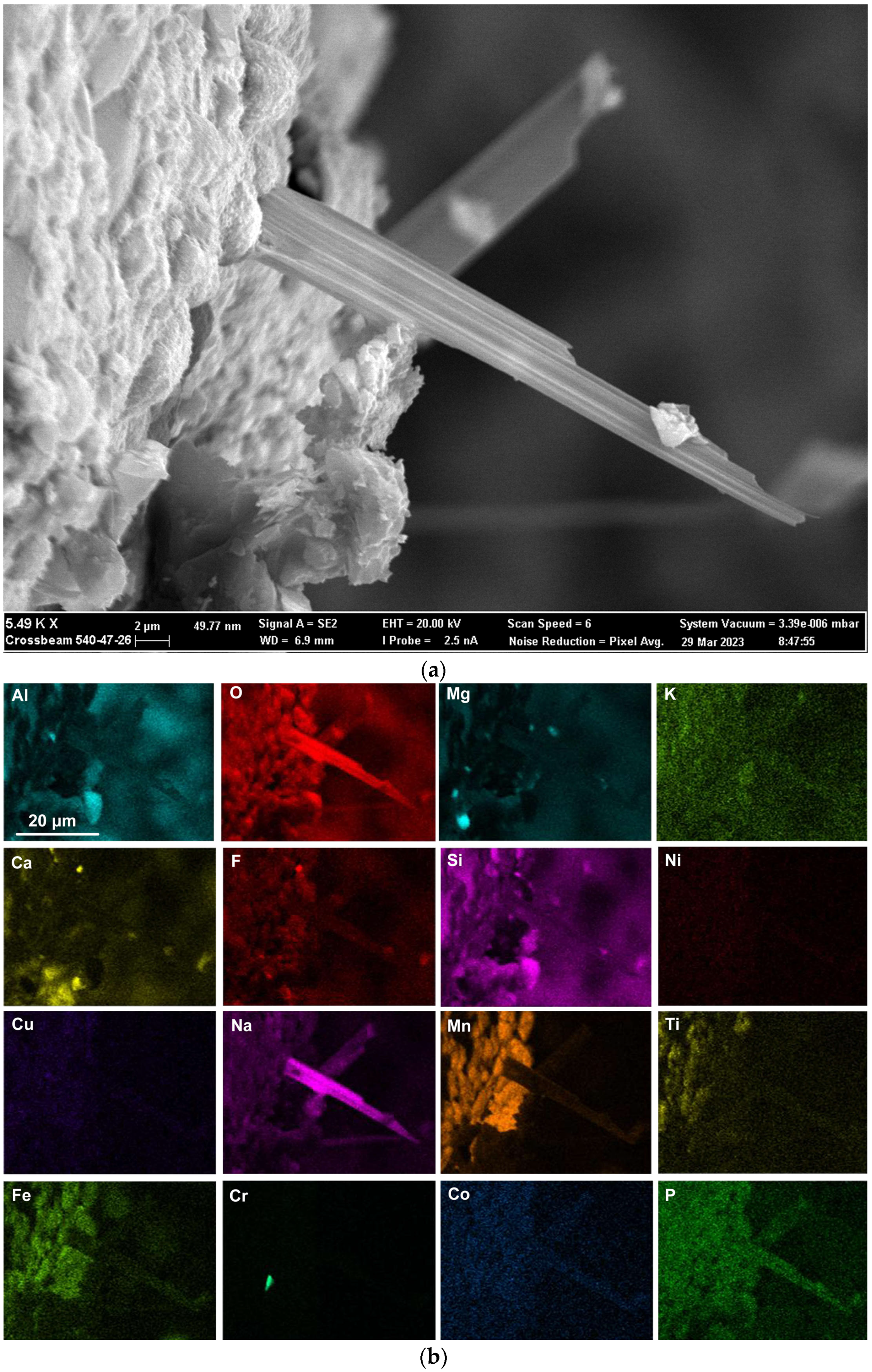

4. Discussion
4.1. EERZ (Effective Equilibrium Reaction Zone) Model
4.1.1. Model Background
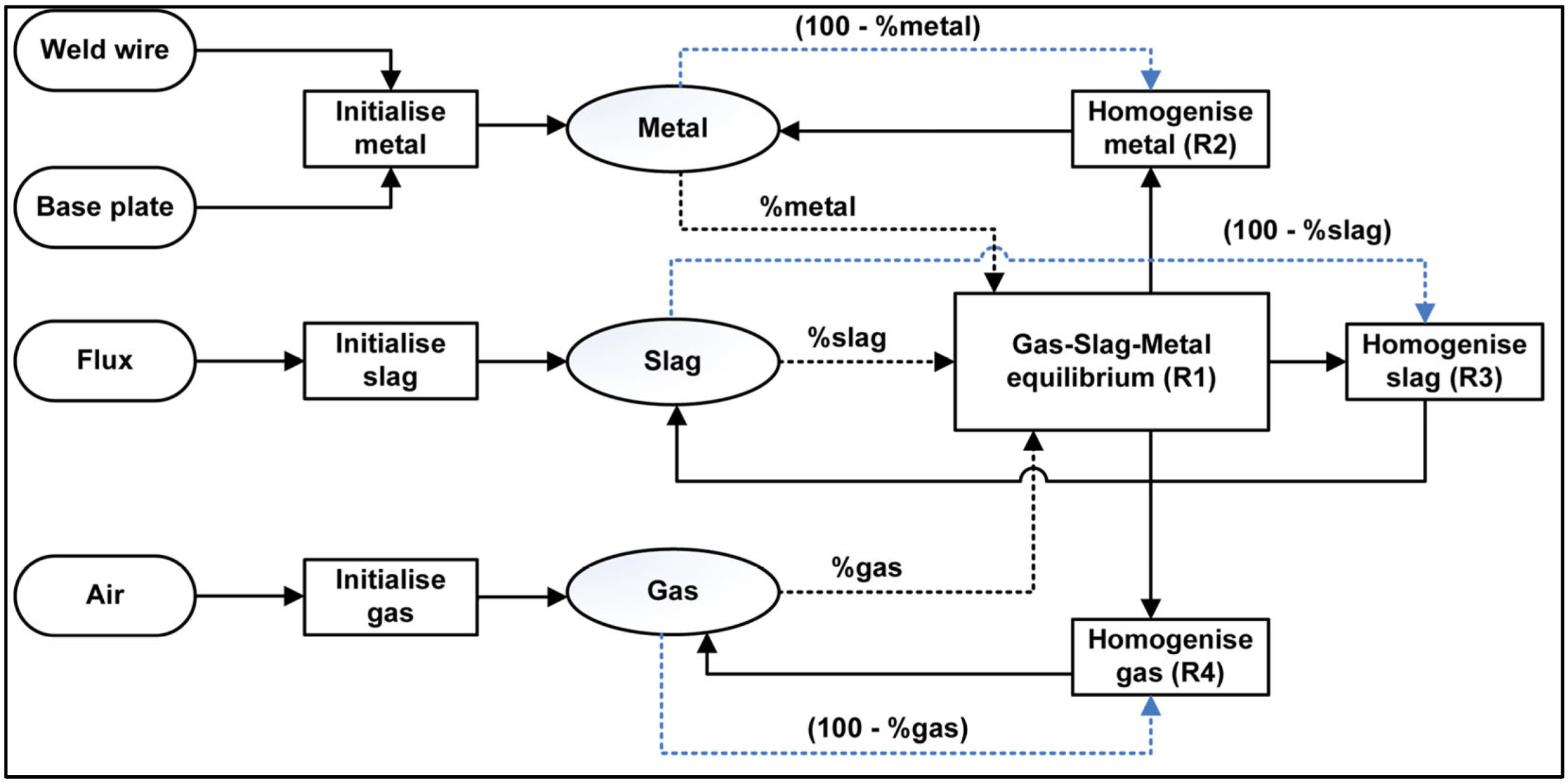
4.1.2. Model Inputs
4.1.3. Model Results and Discussion
| %C | %Si | %Mn | %O | %N | %Al | %P | %S | %Ni | %Cr | %Cu | %Co | %Fe | |
|---|---|---|---|---|---|---|---|---|---|---|---|---|---|
| Model | 0.068 | 0.292 | 0.882 | 0.0257 | 0.0044 | 5.165 | 0.009 | 0.011 | 5.849 | 5.844 | 5.708 | 5.855 | 70.25 |
| MP12 | 0.097 | 0.697 | 1.340 | 0.0257 | 0.0050 | 3.940 | 0.021 | 0.008 | 4.817 | 4.890 | 4.673 | 4.750 | 74.69 |

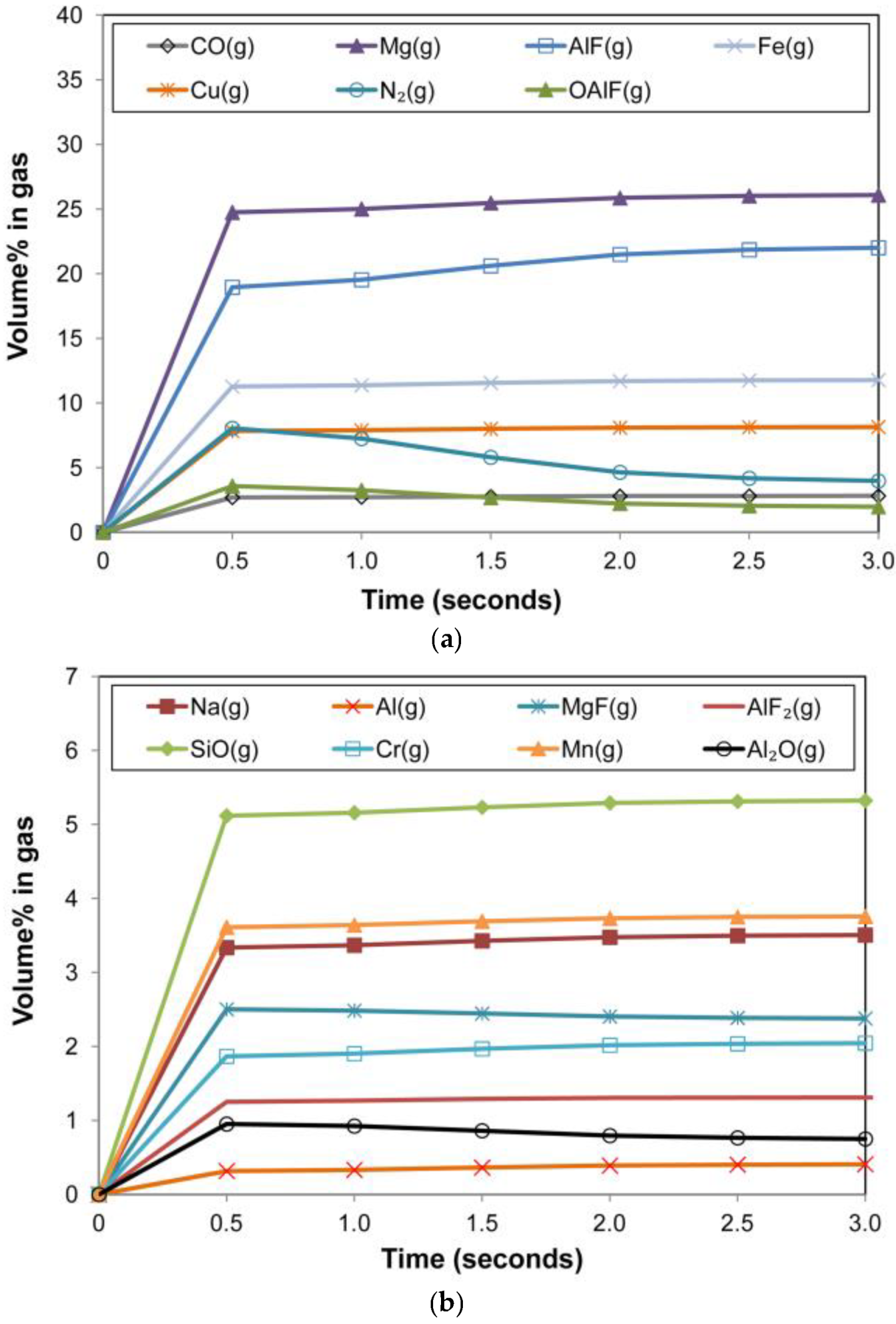
4.2. SAW Process Metallurgy Reaction Flow Diagram for Al, Ni, Cr, Co, and Cu Metal Powder Additions
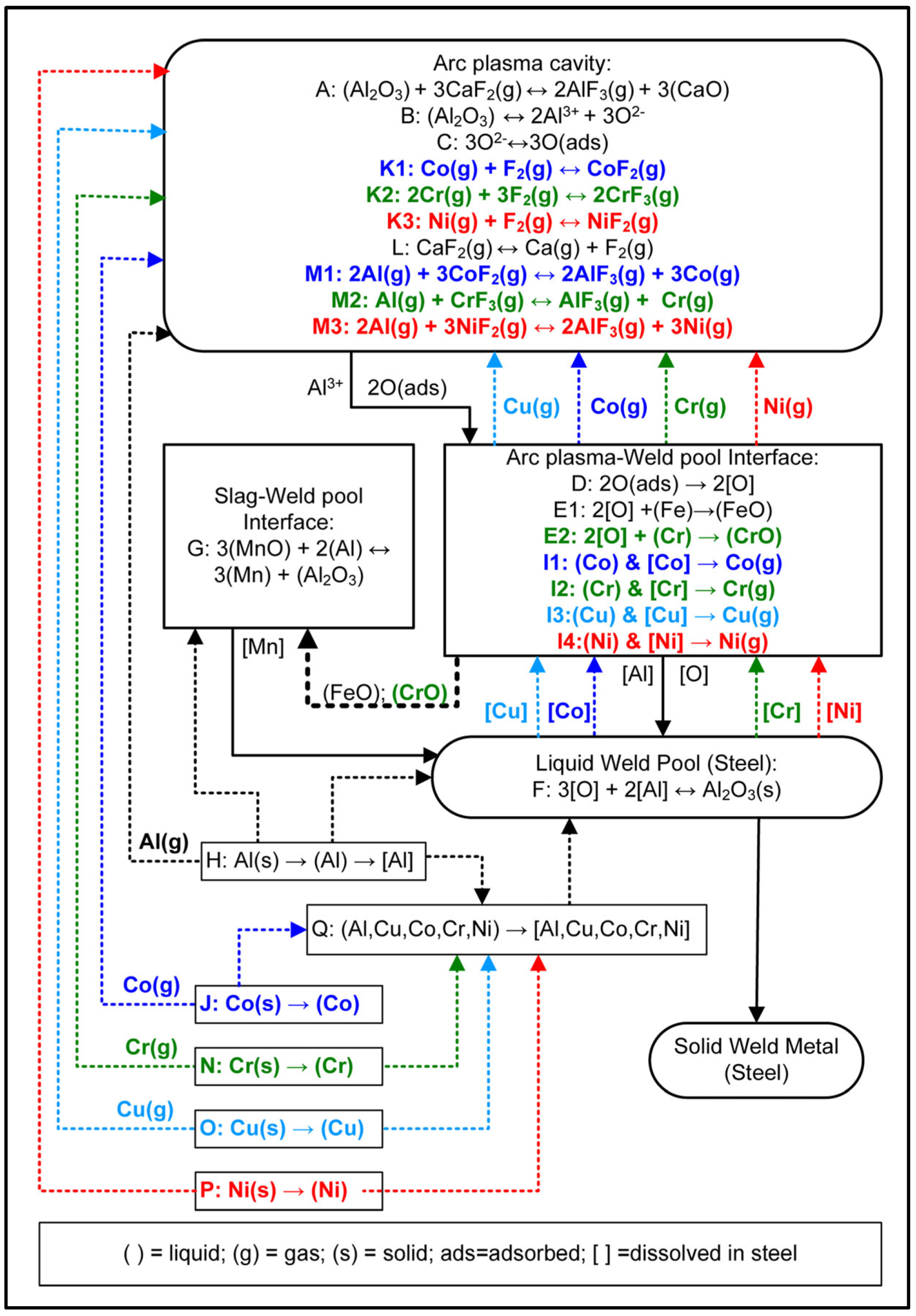
5. Conclusions
- The combination of Al, Ni, Cr, Co, and Cu unconstrained metal powders were successfully applied in SAW to alloy carbon steel weld metal whilst controlling the total weld metal ppm O at an acceptable level.
- Nano-scale 3D oxy-fluoride structures were identified in the dome cavity of the 3D slag sample, indicating that the vaporisation and re-condensation of oxy-fluorides occurred. These oxy-fluorides also contained the elements of Co, Cr, Ni, and Cu which were added to the SAW process as unconstrained metal alloying powders.
- The EERZ (effective equilibrium reaction zone) model was developed to simulate the mass transfer effects in the SAW process. This model was successfully applied to calculate the gas-slag-metal phase chemistry changes with welding time at the arc cavity temperature of 2500 °C.
- The EERZ (effective equilibrium reaction zone) model can calculate the weld metal total ppm O accurately.
- The added unconstrained metal powders increased the deposition rate value to 7.1 kg/h, compared to 5.2 kg/h for the base case weld, representing an increase of 36% in deposition rate for the same applied welding parameters.
Author Contributions
Funding
Data Availability Statement
Conflicts of Interest
References
- Sengupta, V.; Havrylov, D.; Mendex, P.F. Physical phenomena in the weld zone of submerged arc welding—A Review. Weld. J. 2019, 98, 283–313. [Google Scholar]
- O’Brien, A. Welding Handbook—Materials and Applications, Part 1, 9th ed.; American Welding Society (AWS): Miami, FL, USA, 2011; Volume 4. [Google Scholar]
- Bong, W.L. System and Method for Metal Powder Welding. U.S. Patent 8,946,582 B1, 18 October 2016. [Google Scholar]
- Bailey, N. Submerged Arc Welding ferritic steels with alloyed metal powder. Weld. J. 1991, 70, 187–206. [Google Scholar]
- Nand, S.; Singh, P.K. Effect of addition of metal powder on deposition rate, mechanical properties, and metallographic property of weld joints during Submerged Arc Welding process. J. Mach. Form. Technol. 2015, 6, 159–168. [Google Scholar]
- Tušek, J.; Suban, M. High-productivity multiple-wire Submerged-Arc Welding and cladding with metal-powder addition. J. Mater. Process. Technol. 2003, 133, 207–213. [Google Scholar] [CrossRef]
- Hallén, H.; Johansson, K.-E. Use of a Metal Powder for Surface Coating by Submerged Arc Welding. U.S. Patent 6331688 B1, 18 December 2001. [Google Scholar]
- Coetsee, T.; De Bruin, F. Aluminium Assisted Nickel Alloying in Submerged Arc Welding of Carbon Steel: Application of Unconstrained Metal Powders. Appl. Sci. 2022, 12, 5392. [Google Scholar] [CrossRef]
- Coetsee, T.; De Bruin, F. Modification of Flux Oxygen Behaviour via Co-Cr-Al Unconstrained Metal Powder Additions in Submerged Arc Welding: Gas Phase Thermodynamics and 3D Slag SEM Evidence. Processes 2022, 10, 2452. [Google Scholar] [CrossRef]
- Coetsee, T.; De Bruin, F.J. Improved titanium transfer in Submerged Arc Welding of carbon steel through aluminium addition. Miner. Process. Extr. Metall. Rev. 2021, 43, 771–774. [Google Scholar] [CrossRef]
- Coetsee, T.; De Bruin, F. Application of Copper as Stabiliser in Aluminium Assisted Transfer of Titanium in Submerged Arc Welding of Carbon Steel. Processes 2021, 9, 1763. [Google Scholar] [CrossRef]
- Coetsee, T.; De Bruin, F.J. Reactions at the molten flux-weld pool interface in submerged arc welding. High Temp. Mater. Process. 2021, 40, 421–427. [Google Scholar] [CrossRef]
- Coetsee, T.; De Bruin, F. Chemical Interaction of Cr-Al-Cu Metal Powders in Aluminum-Assisted Transfer of Chromium in Submerged Arc Welding of Carbon Steel. Processes 2022, 10, 296. [Google Scholar] [CrossRef]
- Coetsee, T.; De Bruin, F. Aluminium-Assisted Alloying of Carbon Steel in Submerged Arc Welding: Application of Al-Cr-Ti-Cu Unconstrained Metal Powders. Processes 2022, 10, 452. [Google Scholar] [CrossRef]
- Coetsee, T.; De Bruin, F. Application of Unconstrained Cobalt and Aluminium Metal Powders in the Alloying of Carbon Steel in Submerged Arc Welding: Thermodynamic Analysis of Gas Reactions. Appl. Sci. 2022, 12, 8472. [Google Scholar] [CrossRef]
- Coetsee, T.; De Bruin, F. Aluminium-Assisted Alloying of Carbon Steel in Submerged Arc Welding with Al-Cr-Ni Unconstrained Metal Powders: Thermodynamic Interpretation of Gas Reactions. Processes 2022, 10, 2265. [Google Scholar] [CrossRef]
- Coetsee, T.; De Bruin, F. Chemical Behaviour of Copper in the Application of Unconstrained Cr-Ni-Al-Cu Metal Powders in Submerged Arc Welding: Gas Phase Thermodynamics and 3D Slag SEM Evidence. Processes 2023, 11, 351. [Google Scholar] [CrossRef]
- Coetsee, T.; De Bruin, F. Gas Formation of Cobalt and Copper in the Application of Unconstrained Co-Cr-Al-Cu Metal Powders in Submerged Arc Welding: Gas Phase Thermodynamics and 3D Slag SEM Evidence. Processes 2023, 11, 1116. [Google Scholar] [CrossRef]
- Dallam, C.B.; Liu, S.; Olson, D.L. Flux composition dependence of microstructure and toughness of submerged arc HSLA weldments. Weld. J. 1985, 64, 140–152. [Google Scholar]
- O’Brien, A. Welding Handbook—Welding Processes, Part 1, 9th ed.; American Welding Society (AWS): Miami, FL, USA, 1994; Volume 2. [Google Scholar]
- Eagar, T.W. Sources of weld metal oxygen contamination during submerged arc welding. Weld. J. 1978, 57, 76–80. [Google Scholar]
- Chai, C.S.; Eagar, T.W. Slag metal reactions in binary CaF2-metal oxide welding fluxes. Weld. J. 1982, 61, 229–232. [Google Scholar]
- Tuliani, S.S.; Boniszewski, T.; Eaton, N.F. Notch toughness of commercial submerged arc weld metal. Weld. Met. Fabr. 1969, 37, 327–339. [Google Scholar]
- Lau, T.; Weatherly, G.C.; Mc Lean, A. Gas/Metal/Slag reactions in Submerged Arc Welding using CaO-Al2O3 based fluxes. Weld. J. 1986, 65, 31–38. [Google Scholar]
- Polar, A.; Indacochea, J.E.; Blander, M. Electrochemically generated oxygen contamination in submerged arc welding. Weld. J. 1990, 69, 68–74. [Google Scholar]
- Lau, T.; Weatherly, G.C.; Mc Lean, A. The sources of oxygen and nitrogen contamination in submerged arc welding using CaO-Al2O3 based fluxes. Weld. J. 1985, 64, 343–347. [Google Scholar]
- Mitra, U.; Eagar, T.W. Slag metal reactions during submerged arc welding of alloy steels. Metall. Trans. B 1984, 15, 217–227. [Google Scholar] [CrossRef]
- Gött, G.; Gericke, A.; Henkel, K.-M.; Uhrlandt, D. Optical and spectroscopic study of a submerged arc welding cavern. Weld. J. 2016, 95, 491–499. [Google Scholar]
- Raabe, D.; Tasan, C.C.; Springer, H.; Bausch, M. From high-entropy alloys to high-entropy steels. Steel Res. Int. 2015, 86, 1127–1138. [Google Scholar] [CrossRef]
- Moon, J.; Ha, H.-Y.; Kim, K.-W.; Park, S.-J.; Lee, T.-H.; Kim, S.-D.; Jang, J.H.; Jo, H.-H.; Hong, H.-U.; Lee, B.H.; et al. A new class of lightweight, stainless steels with ultra-high strength and large ductility. Sci. Rep. 2020, 10, 12140. [Google Scholar] [CrossRef]
- Coetsee, T.; Mostert, R.J.; Pistorius, P.G.H.; Pistorius, P.C. The effect of flux chemistry on element transfer in Submerged Arc Welding: Application of thermochemical modelling. Mater. Res. Technol. 2021, 11, 2021–2036. [Google Scholar] [CrossRef]
- Coetsee, T.; De Bruin, F. A Review of the Thermochemical Behaviour of Fluxes in Submerged Arc Welding: Modelling of Gas Phase Reactions. Processes 2023, 11, 658. [Google Scholar] [CrossRef]
- Coetsee, T. Phase chemistry of Submerged Arc Welding (SAW) fluoride based slags. Mater. Res. Technol. 2020, 9, 9766–9776. [Google Scholar] [CrossRef]
- Coetsee, T.; De Bruin, F. In Situ Modification of CaF2-SiO2-Al2O3-MgO Flux Applied in the Aluminium-Assisted Transfer of Titanium in the Submerged Arc Welding of Carbon Steel: Process Mineralogy and Thermochemical Analysis. Minerals 2022, 12, 604. [Google Scholar] [CrossRef]
- Coetsee, T.; De Bruin, F. Insight into the Chemical Behaviour of Chromium in CaF2-SiO2-Al2O3-MgO Flux Applied in Aluminium-Assisted Alloying of Carbon Steel in Submerged Arc Welding. Minerals 2022, 12, 1397. [Google Scholar] [CrossRef]
- Kluken, A.O.; Grong, Ø. Mechanisms of inclusion formation in Al-Ti-Si-Mn deoxidized steel weld metals. Metall. Trans. A 1989, 20, 1335–1349. [Google Scholar] [CrossRef]
- Van Ende, M.-A.; Kim, Y.-M.; Cho, M.-K.; Jung, I.-H. A kinetic model for the Ruhrstahl Heraeus (RH) degassing process. Metall. Trans. B 2011, 42, 477–489. [Google Scholar] [CrossRef]
- Piva, S.P.T.; Kumar, D.; Pistorius, P.C. Modeling manganese silicate inclusion composition changes during ladle treatment using FactSage macros. Metall. Trans. B 2017, 48, 37–45. [Google Scholar] [CrossRef]
- Chai, C.S.; Eagar, T.W. Slag-metal equilibrium during submerged arc welding. Metall. Trans. B 1981, 12, 539–547. [Google Scholar] [CrossRef]
- Mitra, U.; Eagar, T.W. Slag-metal reactions during welding: Part I. Evaluation and reassessment of existing theories. Metall. Trans. B 1991, 22, 65–71. [Google Scholar] [CrossRef]
- Bale, C.W.; Bélisle, E.; Chartrand, P.; Decterov, S.; Eriksson, G.; Gheribi, A.E.; Hack, K.; Jung, I.-H.; Kang, Y.-B.; Melançon, J.; et al. Reprint of: FactSage thermochemical software and databases, 2010–2016. Calphad 2016, 55, 1–19. [Google Scholar] [CrossRef]
- Turkdogan, E.T. Fundamentals of Steelmaking; The Institute of Materials: Cambridge, UK, 1996. [Google Scholar]
- You, D.; Michelic, S.K.; Bernhard, C. Modeling of Ladle Refining Process Considering Mixing and Chemical Reaction. Steel Res. Int. 2020, 91, 2000045. [Google Scholar] [CrossRef] [Green Version]
- Poirier, D.R.; Geiger, G.H. Transport Phenomena in Materials Processing; TMS: Warrendale, PA, USA, 1994. [Google Scholar]
- Mitra, U.; Eagar, T.W. Slag-metal reactions during welding: Part II. Theory. Metall. Trans. B 1991, 22, 73–81. [Google Scholar] [CrossRef]
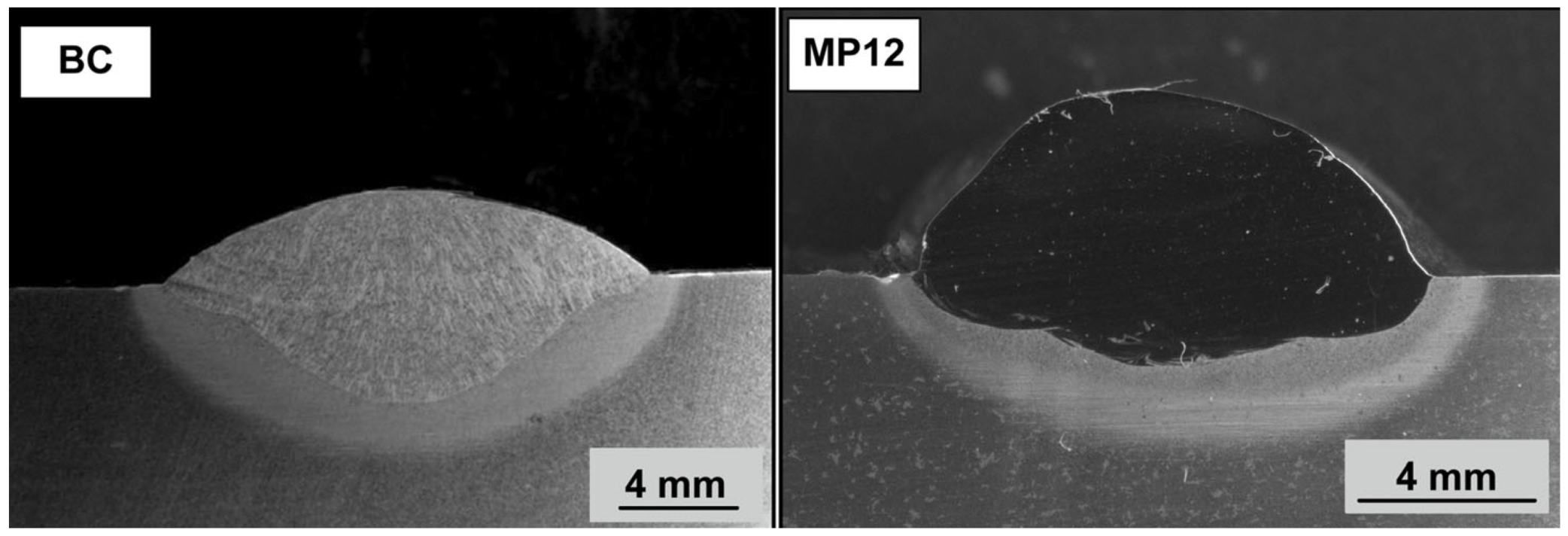
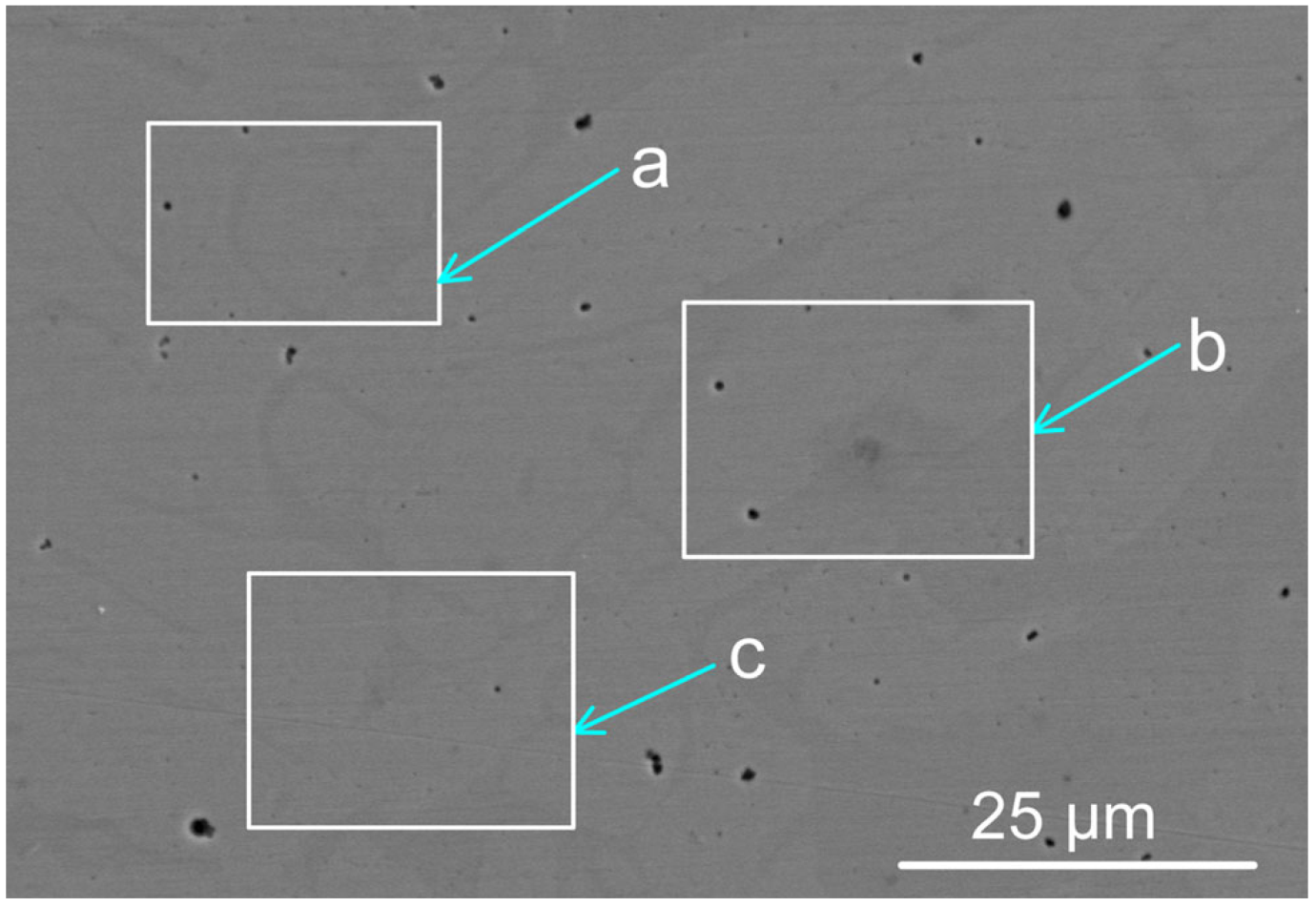

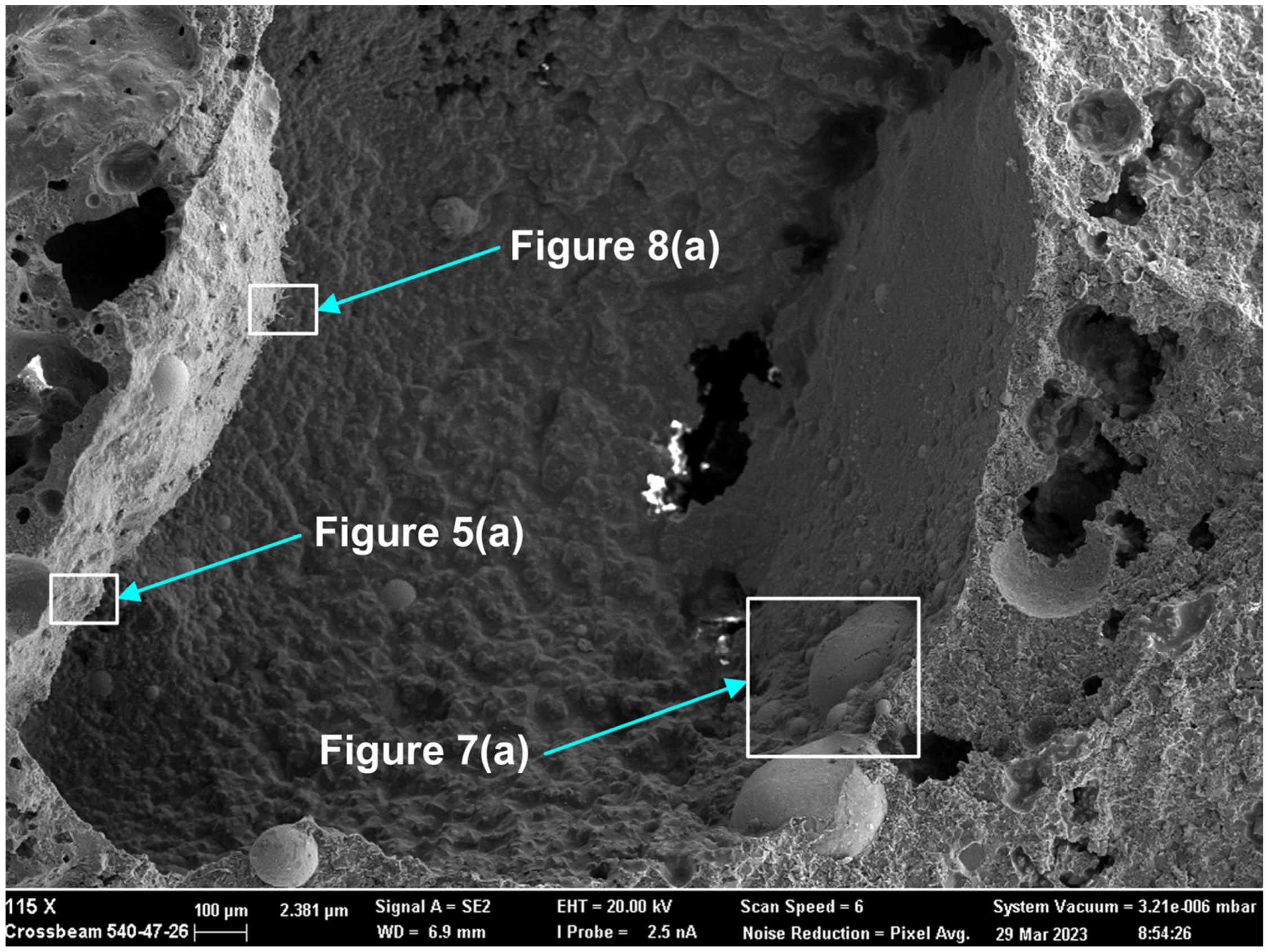
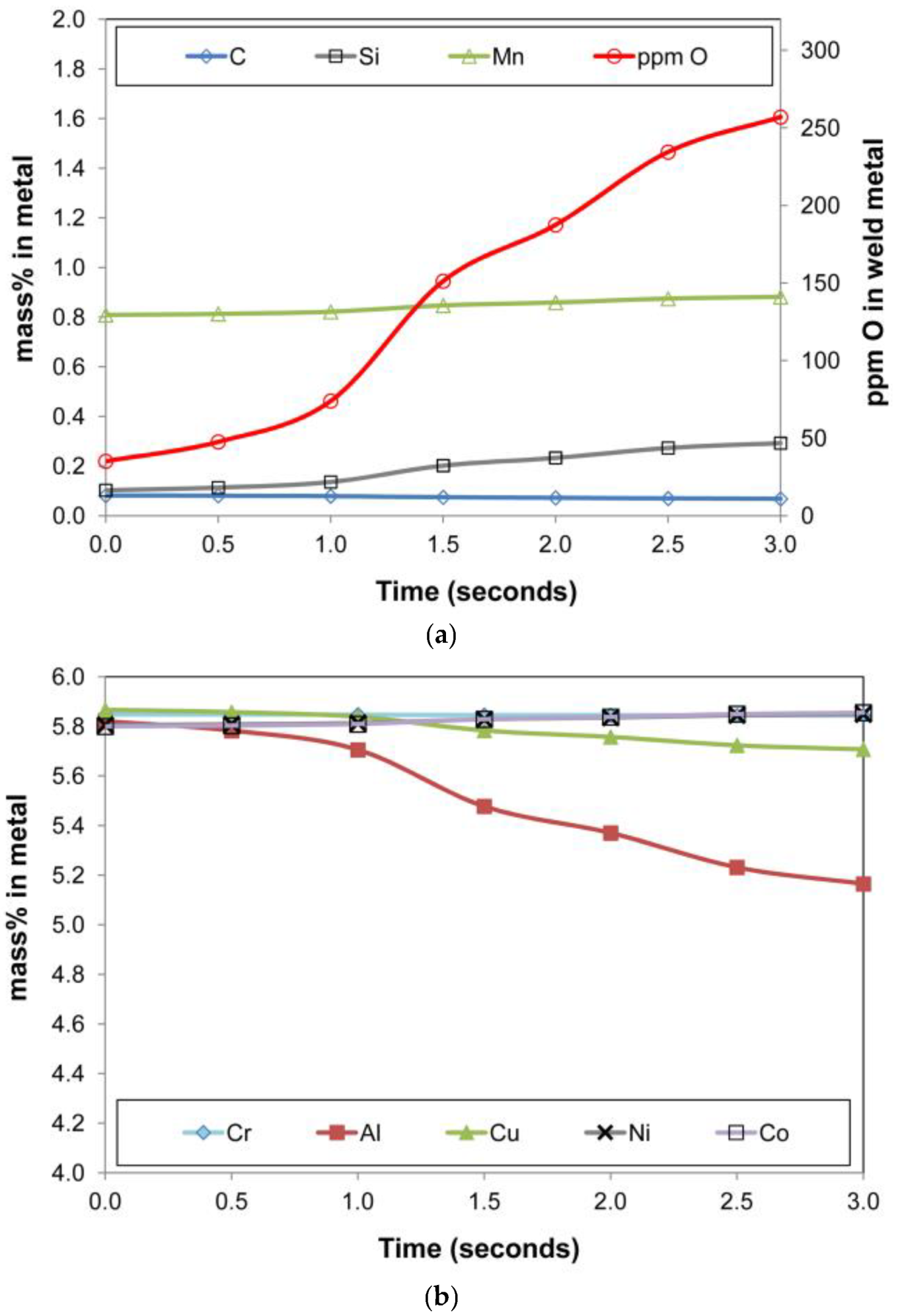

| %C | %Si | %Mn | %O | %Al | %P | %S | %Ni | %Cr | %Cu | %Co | %Fe | |
|---|---|---|---|---|---|---|---|---|---|---|---|---|
| Base Case | 0.110 | 0.260 | 1.300 | 0.0499 | 0.032 | 0.022 | 0.011 | 0.005 | 0.110 | 0.110 | 0.003 | 98.03 |
| MP12 | 0.097 | 0.697 | 1.340 | 0.0257 | 3.940 | 0.021 | 0.008 | 4.817 | 4.890 | 4.673 | 4.750 | 74.69 |
| %Si | %Mn | %Al | %Ni | %Cr | %Cu | %Co | %Fe | |
|---|---|---|---|---|---|---|---|---|
| a | 0.70 | 1.50 | 3.50 | 4.20 | 4.40 | 3.90 | 4.80 | 77.0 |
| b | 0.80 | 1.50 | 3.60 | 4.20 | 4.50 | 4.00 | 4.70 | 76.7 |
| c | 0.54 | 1.42 | 2.66 | 4.00 | 4.50 | 3.91 | 4.67 | 78.3 |
| Al (g) | Ni (g) | Cr (g) | Co (g) | Cu (g) | Powder (g) | Wire (g) | Base Plate (g) | Weld Metal (g) | %DR(wire + MP) | %Al Yield | %Ni Yield | %Cr Yield | %Co Yield | %Cu Yield | |
|---|---|---|---|---|---|---|---|---|---|---|---|---|---|---|---|
| MP12 | 4.4 | 5.4 | 5.4 | 5.3 | 5.2 | 25.7 | 49.3 | 36.4 | 111.4 | 67 | 62 | 76 | 77 | 75 | 74 |
| SiO2 (g) | MnO (g) | Al (g) | Reaction (2) (kJ) | Reaction (3) (kJ) | Reactions (2) and (3) (kJ) | Weld Metal ΔT (°C) | |
|---|---|---|---|---|---|---|---|
| MP12 | 1.31 | 0.25 | 0.85 | −2.39 | −0.59 | −2.98 | 58 |
| Figure | %F | %O | %Al | %Si | %Mg | %Ca | %Mn | %Fe | %Cu | %Na | %K | %Ti | %Cr | %Co | %Ni |
|---|---|---|---|---|---|---|---|---|---|---|---|---|---|---|---|
| 5 | 9.5 | 33.8 | 9.9 | 7.6 | 9.3 | 5.2 | 11.8 | 4.5 | 0.8 | 2.9 | 0.9 | 1.8 | 1.0 | 0.7 | 0.1 |
| 6 | 1.7 | 20.4 | 1.7 | 3.4 | 1.8 | 0.6 | 39.8 | 16.9 | 0.8 | 2.0 | 0.2 | 0.3 | 1.3 | 8.5 | 0.3 |
| 7 | 6.6 | 29.6 | 8.1 | 10.4 | 9.7 | 5.4 | 8.2 | 15.8 | 1.3 | 1.8 | 0.3 | 1.3 | 0.8 | 0.4 | 0.2 |
| 8 | 8.3 | 42.4 | 7.9 | 6.9 | 8.3 | 3.9 | 14.1 | 1.2 | 0.1 | 5.3 | 0.5 | 0.8 | 0.0 | 0.0 | 0.0 |
| 9 | 5.0 | 26.4 | 9.9 | 13.0 | 9.2 | 7.0 | 5.9 | 11.4 | 0.6 | 2.6 | 0.6 | 7.4 | 0.2 | 0.1 | 0.1 |
| σ | 0.43 | 0.19 | 0.12 | 0.16 | 0.14 | 0.09 | 0.21 | 0.22 | 0.04 | 0.05 | 0.02 | 0.10 | 0.02 | 0.05 | 0.03 |
| Post-Weld Slag (g) | Metal Powder (g) | Steel Weld Wire (g) | Steel Base Plate (g) | Alloyed Weld Metal (g) | Welding Time (s) |
|---|---|---|---|---|---|
| 39.1 | 35.0 | 49.3 | 36.4 | 111.4 | 38.2 |
| 1600 °C | 1800 °C | 2000 °C | 2200 °C | 2400 °C | 2500 °C | |
|---|---|---|---|---|---|---|
| [%O] | 0.23 | 0.49 | 0.91 | 1.53 | 2.39 | 2.91 |
| ) | −8.3 | −7.0 | −6.1 | −5.3 | −4.7 | −4.5 |
Disclaimer/Publisher’s Note: The statements, opinions and data contained in all publications are solely those of the individual author(s) and contributor(s) and not of MDPI and/or the editor(s). MDPI and/or the editor(s) disclaim responsibility for any injury to people or property resulting from any ideas, methods, instructions or products referred to in the content. |
© 2023 by the authors. Licensee MDPI, Basel, Switzerland. This article is an open access article distributed under the terms and conditions of the Creative Commons Attribution (CC BY) license (https://creativecommons.org/licenses/by/4.0/).
Share and Cite
Coetsee, T.; De Bruin, F. EERZ (Effective Equilibrium Reaction Zone) Model of Gas-Slag-Metal Reactions in the Application of Unconstrained Al-Ni-Cr-Co-Cu Metal Powders in Submerged Arc Welding: Model and 3D Slag SEM Evidence. Processes 2023, 11, 2110. https://doi.org/10.3390/pr11072110
Coetsee T, De Bruin F. EERZ (Effective Equilibrium Reaction Zone) Model of Gas-Slag-Metal Reactions in the Application of Unconstrained Al-Ni-Cr-Co-Cu Metal Powders in Submerged Arc Welding: Model and 3D Slag SEM Evidence. Processes. 2023; 11(7):2110. https://doi.org/10.3390/pr11072110
Chicago/Turabian StyleCoetsee, Theresa, and Frederik De Bruin. 2023. "EERZ (Effective Equilibrium Reaction Zone) Model of Gas-Slag-Metal Reactions in the Application of Unconstrained Al-Ni-Cr-Co-Cu Metal Powders in Submerged Arc Welding: Model and 3D Slag SEM Evidence" Processes 11, no. 7: 2110. https://doi.org/10.3390/pr11072110






